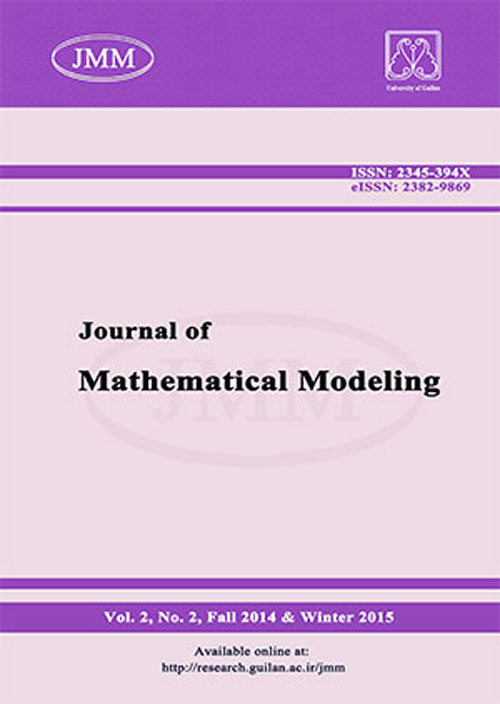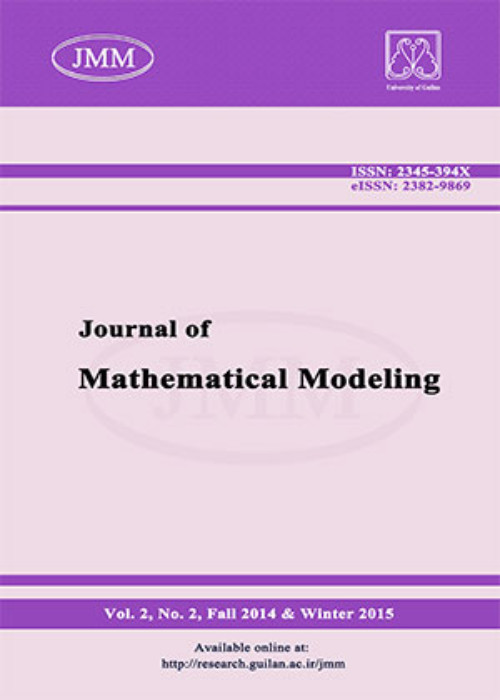فهرست مطالب

Journal of Mathematical Modeling
Volume:9 Issue: 1, Autumn 2021
- تاریخ انتشار: 1399/10/09
- تعداد عناوین: 10
-
Pages 1-12
The elasticity interface problems occur frequently when two or more materials meet. In this paper, a meshfree point collocation method based on moving kriging interpolation is proposed for solving the two-phase elasticity system with an arbitrary interface. The moving kriging shape function and its derivatives are constructed by moving kriging interpolation technique. Since the shape function possesses the Kronecker delta property then the Dirichlet boundary condition can be implemented directly and easily. Numerical results demonstrate the accuracy and efficiency of the proposed method for the studied problems with constant and variable coefficients.
Keywords: Two-phase elasticity system, meshfree method, moving kriging interpolation (MKI), interfaceproblems -
Pages 13-30
We consider in this paper the $l_0$-norm based dictionary learning approach combined with total variation regularization for the image restoration problem. It is formulated as a nonconvex nonsmooth optimization problem. Despite that this image restoration model has been proposed in many works, it remains important to ensure that the considered minimization method satisfies the global convergence property, which is the main objective of this work. Therefore, we employ the proximal alternating linearized minimization method whereby we demonstrate the global convergence of the generated sequence to a critical point. The results of several experiments demonstrate the performance of the proposed algorithm for image restoration.
Keywords: Image deblurring, dictionary learning, sparse approximation, total variation, proximal methods, nonconvex optimization -
Pages 31-44
We extend the method presented by Xu and Zheng (Int. J. Theor. Appl. Finance 17 (2014) 21--36) for the general case. We develop a numerical-analytic formula for pricing nonlinear basket options with jump-diffusion model. We derive an easily computed method by using the asymptotic expansion to find the approximate value of the lower bound of nonlinear European basket call prices since a nonlinear basket option is generally not closed-form. We use Split Step Backward Euler and Compensated Split Step Backward Euler methods with Monte Carlo simulation to check the validity of the presented method.
Keywords: Basket option, nonlinear stochastic differential equations, Poisson process, Split Step Backward Euler method -
Pages 45-60
In this paper, we study a non-autonomous time-delayed SIR epidemic model which involves almost periodic incidence rate and saturated treatment function on time scales. By utilizing some dynamic inequalities on time scales, sufficient conditions are derived for the permanence of the SIR epidemic model and we also obtain the existence and uniform asymptotic stability of almost periodic positive solutions for the addressed SIR model by Lyapunov functional method. Finally numerical simulations are given to demonstrate our theoretical results.
Keywords: SIR model, time scale, almost periodic incidence rate, almost periodic positive solution, permanence, uniform asymptotic stability -
Pages 61-79
Two different numerical methods are developed to find approximate solutions of a class of linear fractional differential equations (LFDEs) appearing in the study of the generalized Basset force, when a sphere sinks in a viscous fluid. In the first one, using the Chebyshev bases, the collocation points, and the matrix operations, the given LFDE reduces to a matrix equation while in the second one, we employ the local discontinuous Galerkin (LDG) method, which uses the natural upwind flux yielding a stable discretization. Unlike the first method, in the latter method we are able to solve the problem element by element locally and there is no need to solve a full global matrix. The efficiency of the proposed algorithms are shown via some numerical examples.
Keywords: Basset equation, Caputo fractional derivative, Chebyshev polynomials, collocation method, local discontinuous Galerkin method, numerical stability -
Pages 81-92
In this paper, our concern is to present and solve the problem of pricing oil futures. For this purpose, firstly we suggest a model based on the well-known Schwartz's model, in which the oil futures price is based on spot price of oil and convenience yield, however, the main difference here is that we have assumed that the former was imposed to some jumps, thus we added a jump term to the model of spot price. In our case, the oil future price model would be a Partial Integral Differential Equation (PIDE). Since, no closed form solution can be suggested for these kind of equations, we desire to solve our model with an appropriate numerical method. Although Finite Differences (FD) or Finite Elements (FE) is a common method for doing so, in this paper, we propose an alternative method based on Radial Basis Functions (RBF).
Keywords: Oil derivative market, Radial Basis Functions (RBF), oil futures, initial, boundary valueproblems, jump-diffusion model -
Pages 93-106
This manuscript is concerned about the study of the existence and uniqueness of solutions for fractional differential equation involving Caputo Hadamard fractional operator of order 1<ϑ≤21<ϑ≤2 with impulsive boundary conditions. The existence results are established firstly through the Banach Contraction Principle and then using Schauder's fixed point theorem. We present some examples to demonstrate the application of our main results.
Keywords: Boundary value problem, impulses, Caputo-Hadamard fractional derivative, fixed point theorem -
Pages 107-118
This paper discusses stability and uniform asymptotic stability of the trivial solution of the following coupled systems of fractional differential equations on networks cHDαxi = fi(t, xi) + Pn j=1 gij (t, xi , xj ), t > t0, xi(t0) = xi0, where cHDα denotes the Caputo-Hadamard fractional derivative of order α, 1 < α ≤ 2, i = 1, 2, . . . , n, and fi : R+ × R mi → R mi , gij : R+ × R mi × R mj → R mi are given functions. Based on graph theory and the classical Lyapunov technique, we prove stability and uniform asymptotic stability under suitable sufficient conditions. We also provide an example to illustrate the obtained results.
*The formulas are not displayed correctly.
Keywords: Fractional differential equation, Caputo-Hadamard, Coupled systems on networks, Lyapunovfunction -
Pages 119-135
In this sense, for this new fractional integrodifferential equation, we study the Ulam-Hyers and Ulam-Hyers-Rassias stability via successive approximation method. Further, we investigate the dependence of solutions on the initial conditions and uniqueness via $epsilon-$approximated solution.
Keywords: Ulam-Hyers stability, Ψ−Hilfer fractional derivative, fractional integrodifferential equations, Banach fixed-point theorem -
Pages 137-144
This paper deals with the case of variable weights of the inverse model of the minimax circle location problem. The goal of the classic minimax circle location problem is finding a circle in the plane such that the maximum weighted distance from a given set of existing points to the circumference of the circle is minimized. In the corresponding inverse model, a circle is given and we should modify the weights of existing points with minimum cost, such that the given circle becomes optimal. The radius of the given circle can be fixed or variable. In this paper, both of these cases are investigated and mathematical models are presented for solving them.
Keywords: Minimax circle location, inverse facility location, variable weights


